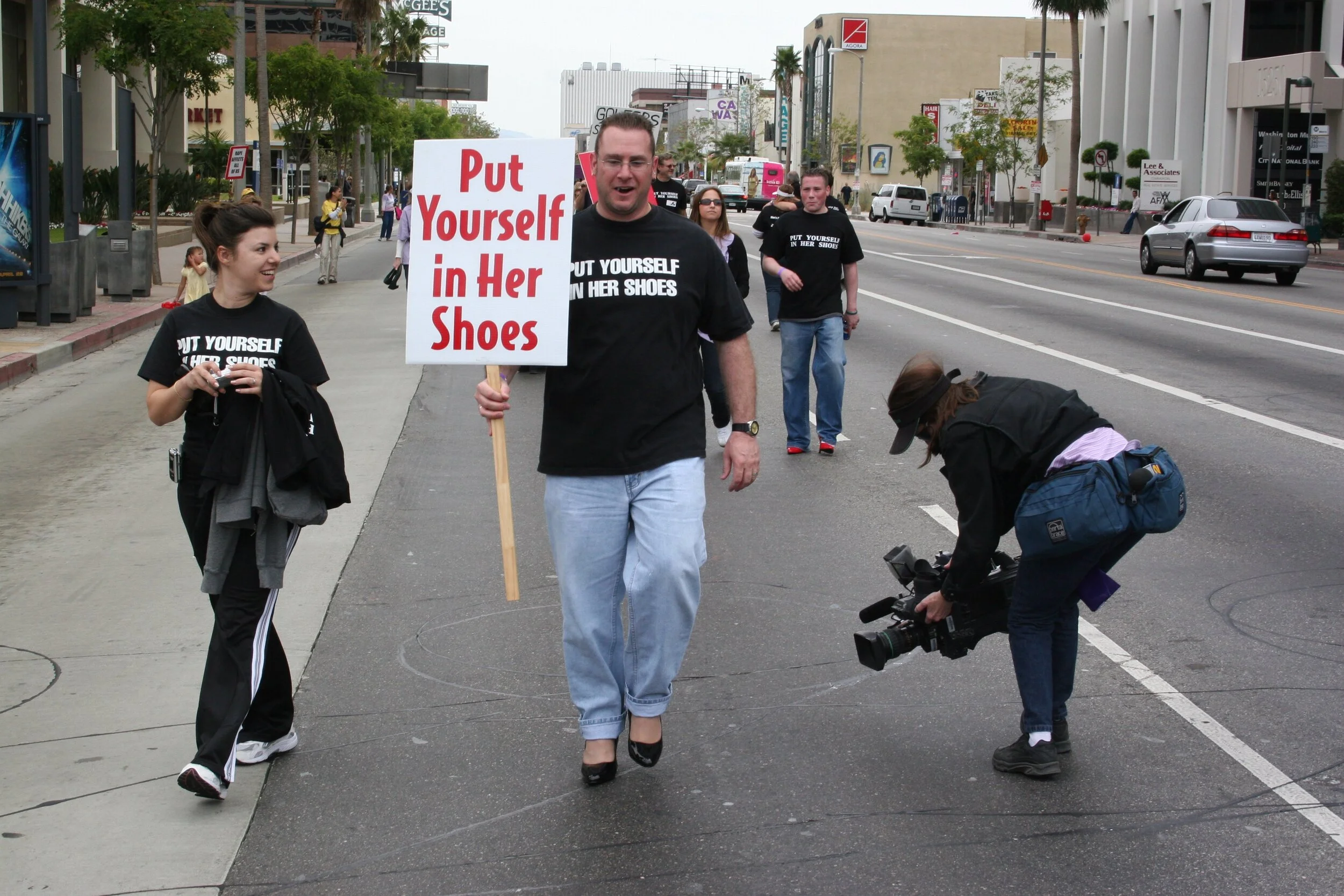Recruit Personnel & Press
Build Walk Attendance - Get the Word Out to the Communtiy
Asking men to Walk in high heels may sound like a daunting task. No problem. No harm in asking. After all, the main point of the Walk is to help build a united gender movement to stop rape, sexual assault & gender violence. Not all men will be prepared to go that extra mile in a pair of high heels, but many men are interested in demonstrating against rape and sexual assault. When getting the word out, emphasize that everyone wishes to help stop rape is welcome to join the Walk. Then, gain their commitment and sign them up to attend the Walk.
It will be important to find a contingent of men (even 10 – 15) who will Walk in high heels. These men are not only making a serious statement with their feet about ending rape, sexual assault, and gender violence, they will be the main attraction for local media.
Use Multiple Modes of Communication to Get the Word Out. Here are a few suggestions for spreading the Walk a Mile in Her Shoes® message:
Post Walk a Mile in Her Shoes® Flyers on College Campuses, local businesses and professional office, bookstores, elected official's offices and anywhere else you think people will see them
Distribute Flyers/Posters to Civil Rights Organizations, Unions, Violence Prevention Organizations, Crisis Centers, Law Enforcement, Religious Organizations, Churches, Mosques, Temples, etc. by:
Fax
Personal Delivery – Save these for those organizations whose members are most likely to attend
E-Mail
Mail you pay for
Mail others pay for – Distribution to members of coalitions, civil rights organizations, etc. by agreement with those coalitions or organizations. For example, the Los Angeles County Domestic Violence Council will often include flyers about anti-violence events free-of-charge as long as it is approved by the group’s Executive Director. The list contains thousands of names.
Newsletter Stories/Ads that focus on or mention the Walk a Mile in Her Shoes®: The Men’s March to Stop Rape, Sexual Assault & Gender Violence. Example: Valley Trauma Center publishes The Advocate and distributes it to volunteers, members of its Advisory Board, and its friends in the community.
Calls to Volunteers and Supporters. This is something that every organization involved in March planning can do to help generate Men’s March attendance. Remember, people often need to hear about an activity several times before they decide to go. If possible, plan to make a couple rounds of calls to sign marchers up, and to identify volunteers necessary to run the march. Then make sure you conduct reminder and follow up calls to confirm participation.
Announce at Meetings, Town Halls, and other Community Events. Remember to bring plenty of flyers to pass out.
Post info on a web site and link to www.walkamileinhershoes.org.
Line Up March Personnel and Volunteers
You are going to need volunteers to support your march, no matter the size. All volunteers should be provided some level of training prior to performing their jobs. Some jobs require little training, and, if absolutely necessary, can be plugged in on the day of the Men’s March.
Volunteer jobs on the day of the march may include:
Registration – Checking in Walkers
Logistical Coordinator/Logistical Support – Setting up chairs, podium, and tables, signing in exhibitors (tables), picking up and/or setting up sound and other equipment
Security Coordinator/Security Volunteers– Making sure Walkers observe traffic laws (when Walking along public sidewalks without street closure). Making sure that hecklers or ill-wishers don’t interfere with the course of the Walk.
Walk Documentation – It’s very important to document your success. Take your own pictures and videotape your activities. Don’t rely on the media to document your event for you. You’ll end up with some precious moments, and some interesting ones too, if you have a good photographer (amateur or professional) and a few volunteers walking around with disposable cameras. Videotape from your Walk can be shown at your next open house, Board of Directors meeting, or spliced into your public relations video project.
Media Coordinator/Media Intern – Your Media Coordinator will interface with all representatives of the media on the day of the event, documenting their coverage, arranging interviews, and helping them set up to capture some great images of your Walk. It helps if there is also a Media Intern present who can handle the media check-in and serve as back up when the Media Coordinator is occupied.
Walk Manager/Program Volunteers – The Walk Manager will coordinate your program and all of the people in the program. S/he will make sure the Walk and other program elements are integrated and will manage volunteers to help her/him in that regard. Program Volunteers will help the Walk Manager to greet, orient and place program participants; make sure Walkers are in the right order (men in high heels, men in sensible shoes, women/youth/children); and, interface with the Media Coordinator/Intern re the presence of spokespersons and their location.
Clean Up – don’t forget to sign up volunteers who are dedicated to this task. It is important to follow the scouting motto to “leave a place better than when you found it.” This will ensure a good reception from public officials the next time you need their help with an event.
Inform the Media
Walk a Mile in Her Shoes®: The Men’s March to Stop Rape, Sexual Assault & Gender Violence is a media-ready campaign. Who would want to pass up a bunch of men walking in high heels carrying anti-rape signs and wearing PUT YOURSELF IN HER SHOES™ tee-shirts? Not many . . . even in large media markets like Los Angeles, the Walks garnered coverage in major newspapers, news radio, and most local and national television news outlets.
Prepare press releases, and public service announcements (read-only) to help interest media in your local Walk. Contact supportive reporters and talk show hosts first to give them a scoop or first opportunity for the story. Then, make sure to distribute media materials at least six-to-eight weeks in advance. Materials can be faxed or mailed to media representatives. Once sent, follow up with every media outlet to make sure your materials were actually received. Do this by checking with the media outlet’s City Desk Editor (print media) or Assignment Desk (electronic/radio and video/television).
Plan Your Program
Make your program dynamic, inspiring, and relatively brief. Remember, the Walk is the point of the event and will take some time to complete. Try to limit your program to about 20 minutes in length MAX.
Identify public figures and organizational leaders who are charismatic speakers and invite them to speak on one of the suggested topics. Be specific about their suggested topic area and the length of time they will have to speak.
Once your speakers are confirmed verbally, confirm them again in writing. Make sure you include the date, time, location, parking arrangements, who they should meet on-site, and any other important information they need to know to be able to participate in your event. Clarify if the speaker will also be participating in the Walk, and how they will be participating (i.e., if a man, will he be wearing high heels?).
When contacting elected officials, discuss the possibility of a proclamation in support of the Walk. Mention all proclamations received, along with the official or official body issuing the proclamation, from the podium during the program. Make sure that there is someone checking the crowd and the registration area for elected officials so they can be mentioned from the podium – thanked for their participation.
Select a strong emcee to make sure your program moves along smoothly. Someone who can start and end the program on time, and who can diplomatically, but resolutely, help a lengthy speaker draw his or her remarks to a close.
Be kind to your speakers. Make sure there is water on the podium and a place for them to sit on or near the stage when they are not delivering their remarks. And, CHECK THE SOUND SYSTEM IN ADVANCE.
4-23-05 - Sherman Oaks, CA, USA

